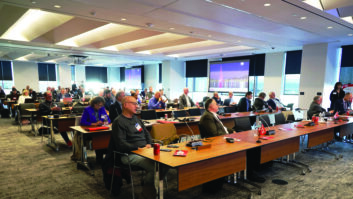Remote Access and Site Connectivity: Wireless
May 1, 2013 5:46 PM, By Doug Irwin, CPBE DRB AMD
Getting an extension of your LAN to a transmitter site (or other remote site) is fairly easy if there are wire-based facilities there. That was our topic last month. However, some sites have no wire-line facilities of any sort, and that can leave you with a tough problem to solve. How does one get access to a studio LAN (and the Internet) from a remote site with no native connectivity? That’s our topic this time around.
There are at least two different approaches to this problem. First, you can see if your remote site is covered by a local wireless ISP (WISP). Secondly, you can build your own system making use of unlicensed ISM band radios. We’ll cover both methods.
As you stand at a transmitter site and contemplate the utter lack of wire-line facilities thereupon, take a look around you. What cities are near? Even though many transmitter sites are remote in the sense that there are no wire facilities and roads may be hazardous, clearly they’re close enough to a town or towns that make up your audience. It’s likely that one or more of those towns has a wireless Internet service provider. When you get back to the office, simply search online for the town plus wireless Internet service provider. I did this very thing recently as part of my work for Clear Channel in Los Angeles. We needed Internet access for our KSRY transmitter site near Tehachapi, CA. A quick online search showed that Creative Wireless is in business in the town of Tehachapi. Ultimately we received up/down speeds of around 3.5Mb/s from them – not bad at all, and more than adequate for the site. Of course since this is the public Internet, we’ll be making use of the appropriate access and security techniques (discussed in last month’s article).
“Sure,” you say. “But that’s in southern California. I’m in (fill-in-the-blank-here). We’re really remote.” Well, in an article I wrote for Radio magazine in August 2012 (radiomagonline.com/issue_20120801) I mentioned a WISP (called Wispernet) that covers Peace River, AB (among other towns). Peace River has a population of 6,750, and is located about 250 miles north of Edmonton. It provides a Layer-2 (Ethernet) connection to its clients CKHL and CKKX there. Some readers may be more remote, but my point is that there are almost always options.
Wireless options
The option that seems most familiar is probably using equipment provided by familiar manufacturers. One system worth looking at is the Intraplex HD Link from Harris Broadcast. It’s a 950MHz radio system that passes not only the typical program audio, but also HD Radio traffic between a studio location and transmitter site. When integrated with an IP return path from the transmitter site back to the studio, the system will pass TCP traffic between the two ends, and will manage packet routing, based on the user configuration, and path accessibility. In other words, it has two network inputs: one for passing HD Radio traffic, and a separate used in conjunction with a return path for TCP traffic.
But, without the benefit of wire-line access to the transmitter site, how would one obtain a return path? That’s where the 900MHz ISM band (or perhaps 2.4GHz or 5.8 GHz) comes in to play. As just one example, let’s take a look at the AvaLAN AW900S. This radio operates in the 902-928MHz ISM band; has 12 non-overlapping channels to choose from; will achieve up to 935kb/s of data throughput (Ethernet interfaces) and will go down to a -97dBm signal level with a 10E-4 BER. Maximum TPO is +21dBm. User configuration is via an embedded Web browser. Antennas that will work for this path are easy to find; you might even have a set of antennas around (like a pair of lawn chairs) that could be used for the link.
Once a return link is established from the transmitter site, integrate it with the Intraplex HD Link in such a way that the radio system will route packets in the appropriate manner so that a duplex IP link is established.Another very familiar option for establishing a TCP/IP link to the transmitter site would be use of the Moseley LanLink. The LanLink Turbo version requires a set of external antennas. The LanLink includes a duplexer on both ends, which affords the user a convenient way to use 950MHz antennas that are already in place. (The current 950MHz radios loop through the duplexer.) Both versions operate in the 902-928MHz ISM band; data throughput up to 130Mb/s. Output power is +28dBm. Configuration is done via an embedded Web server; the unit supports SNMP as well.
Of course you may have no reasons whatsoever to use the 900MHz frequency range for your remote link; you could look at the 2.4 and 5.8GHz bands instead. Some of the available radios are TDM-based, so they have T1 (or perhaps even T3) interfaces. This is somewhat of an old-fashioned approach now, and would necessitate an Ethernet to TDM interface on both ends of the link. (This could be done with routers.) Some radios come with native TDM and Ethernet interfaces, allowing for the best of both worlds.
– continued on page 2
Remote Access and Site Connectivity: Wireless
May 1, 2013 5:46 PM, By Doug Irwin, CPBE DRB AMD
Ceragon manufactures an extensive line of microwave radio systems (several of which are used successfully at Clear Channel in New York). For this topic I’ll point out the FibeAir 4800, which is its product for the license-exempt ISM bands (2.4 and 5.8GHz). The FibeAir 4800 is specified to operate at data rates of up to 48Mb/s; modulation schemes are user-configurable (QPSK, 16QAM or 64QAM); it has native T1 interfaces, along with its Ethernet interface; and comes in three different physical versions – all indoor, all outdoor, or split indoor/outdoor units.
Ubiquiti (used successfully at Clear Channel in Los Angeles) is another manufacturer of license-exempt Ethernet radios. Its Rocket M2 (2.4GHz) and Rocket M5 (5.8GHz) radios are specified to hit data rates as high as 150Mb/s, though 54Mb/s (at -75dBm receive signal level) at 2.4GHz, and 5.8GHz are found from a perusal of the spec sheets. Ubiquiti’s AirView software is included in all the M units, allowing the user to do remote spectrum analysis – clearly useful in setting up the links for the first time, and also troubleshooting later on should the need arise. (The unlicensed bands are subject to interference from other users, after all.) Ubiquiti also offers a line of small dishes that are made to easily integrate with the radios. The Rocket is an outdoor unit; installation consists of the mounting of the dishes, physically connecting the outdoor unit to the chosen antenna, and powering the device over the Ethernet cable.
System expansion
Once you’ve established your radio LAN extension to your remote site, there may be one other problem to consider. What if you have more than one building at the site (say on top of a mountain)? What’s the best way to add all the buildings to the network? The correct answer will depend upon the circumstances, of course. If the buildings are adjacent to one another, then it may be possible to simply connect them via CAT-5e or CAT-6 cables (made for outside and/or direct burial). On the other hand, they may be too far away from each other (or say, across the street) making direct cable connections impractical. Here again you could make use of the same sort of inexpensive ISM band radios we have already gone over to make a network. Obviously you’ll need to make sure you can configure the radios to operate on different channels inside the ISM band choice so the various links can coexist with one another. Some amount of experimentation may be necessary in order to find the best ISM band for the site. Making use of the 900MHz ISM band for example, could be very problematic in the presence of other transmitters operating around 900MHz at a mountain top or other remote site.

Figure 1
Figure 1 illustrates an implementation. At the terminal site for your radio link you’ll simply connect more of the radios up to ports on a Layer-2 switch. Each subsidiary radio link will act as a LAN bridge, so hosts in each of the other buildings will need to be addressed with the same network numbers.
Establishing high-speed Ethernet at a remote site can be very beneficial to the operation of a radio station; access to remote controls, computers, cameras, off-site servers and the like will give your system more functionality and probably make your job easier in the long run. It’s well worth the investment in time and money.
Irwin is RF engineer/project manager for Clear Channel Los Angeles. Contact him at [email protected].
May 2013
WKSU designs to handle noise, wireless site connectivity, Field Reports from Deva and Worldcast APT, 20 years of Radio magazine and some NAB review….












